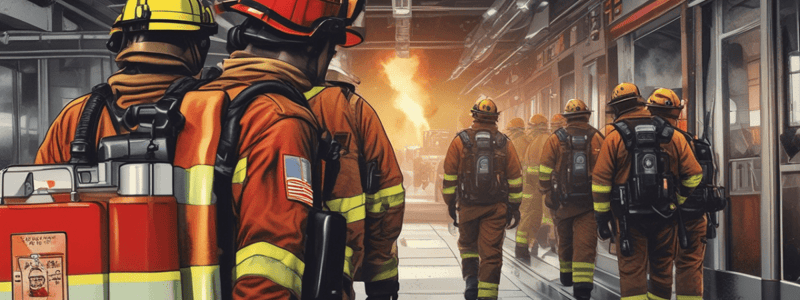Podcast
Questions and Answers
What is the primary reason for operating in teams of two or more firefighters?
What is the primary reason for operating in teams of two or more firefighters?
- To improve firefighting skills
- To facilitate accountability (correct)
- To enhance communication
- To reduce personnel costs
In which situation is operating in teams of two or more mandatory?
In which situation is operating in teams of two or more mandatory?
- During community outreach programs
- During training exercises
- At emergency incidents in controlled areas (correct)
- During regular station duties
What is a controlled area?
What is a controlled area?
- An area where SCBA is required
- An area designated by the Incident Commander
- A area with high risk of injury
- All of the above (correct)
Who is responsible for assigning teams of two or more firefighters?
Who is responsible for assigning teams of two or more firefighters?
How are teams of two or more firefighters assigned?
How are teams of two or more firefighters assigned?
What is a requirement for a Sector Officer working within a controlled area?
What is a requirement for a Sector Officer working within a controlled area?
What do Red Tags represent in the colour coding system?
What do Red Tags represent in the colour coding system?
When can two Red Tags (Probationary Firefighters) be teamed together?
When can two Red Tags (Probationary Firefighters) be teamed together?
What is required for personnel from outside agencies working in a controlled area?
What is required for personnel from outside agencies working in a controlled area?
What is a requirement for a team when entering, working inside and exiting a controlled area?
What is a requirement for a team when entering, working inside and exiting a controlled area?
What is required for Accredited media personnel with an Orange PIT?
What is required for Accredited media personnel with an Orange PIT?
Who can White Tags be teamed with?
Who can White Tags be teamed with?
Flashcards are hidden until you start studying
Study Notes
Team Operations in Emergency Incidents
- Firefighters operate in teams of two or more to enhance safety when working in a controlled area.
- Teams facilitate accountability and aid in Firefighter safety.
When to Operate in Teams
- Teams are required whenever personnel operate within a controlled area at an emergency incident.
- A controlled area is defined as an area where Self Contained Breathing Apparatus (SCBA) is required or where the Incident Commander determines that teams will provide a greater margin of safety.
Team Composition
- Teams are composed of two or more individuals who have been assigned a common task and are in communication with each other.
- Sector Officers required to work within a controlled area must be teamed with a firefighter.
- Teams are assigned based on the colour coding of their Photo Identification Tags (PITs).
PIT Colour Coding
- Red: Probationary Firefighter or Spare PIT
- Yellow: 2nd class Firefighter or 3rd Class Firefighter
- White: First Class Firefighter and above
- Orange: Accredited media personnel
Team Guidelines
- White Tags may be teamed together or with any other colour.
- Yellow and Red Tags or two Yellow Tags can be teamed at the discretion of an Officer.
- Two Red Tags (Probationary Firefighters) are only to be teamed under the direct supervision of a Captain or Acting Captain.
- A Red Tag may be teamed with an Acting Captain or Captain.
- A team shall remain together at all times while entering, working inside, and exiting a controlled area.
Outside Agencies and Media
- Personnel from outside agencies report to the Command Post if called to an emergency incident.
- Outside agency personnel not working in a controlled area work with another person from their agency or with a Firefighter.
- Outside agency personnel working in a controlled area must be accompanied by a minimum of two Firefighters.
- Accredited media personnel with an Orange PIT must be accompanied by a Firefighter or TFS Information Officer at all times.
Studying That Suits You
Use AI to generate personalized quizzes and flashcards to suit your learning preferences.




